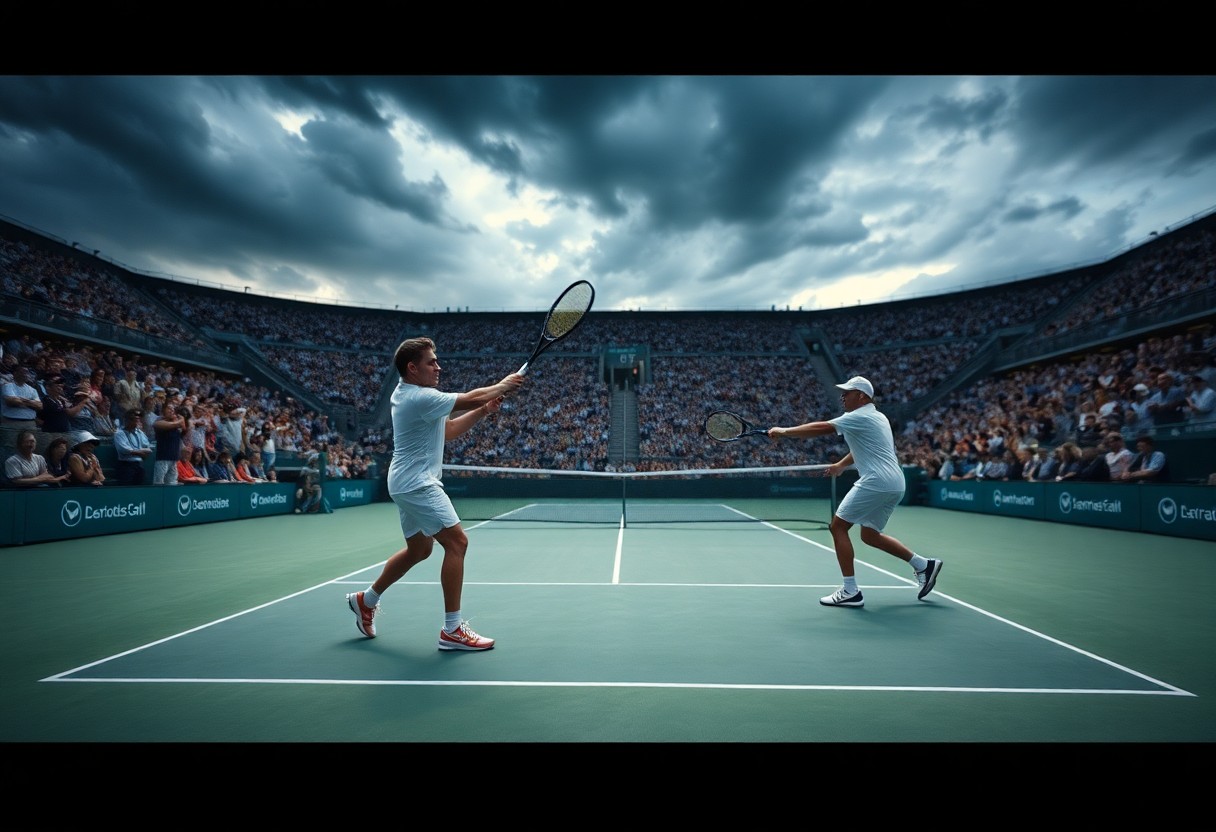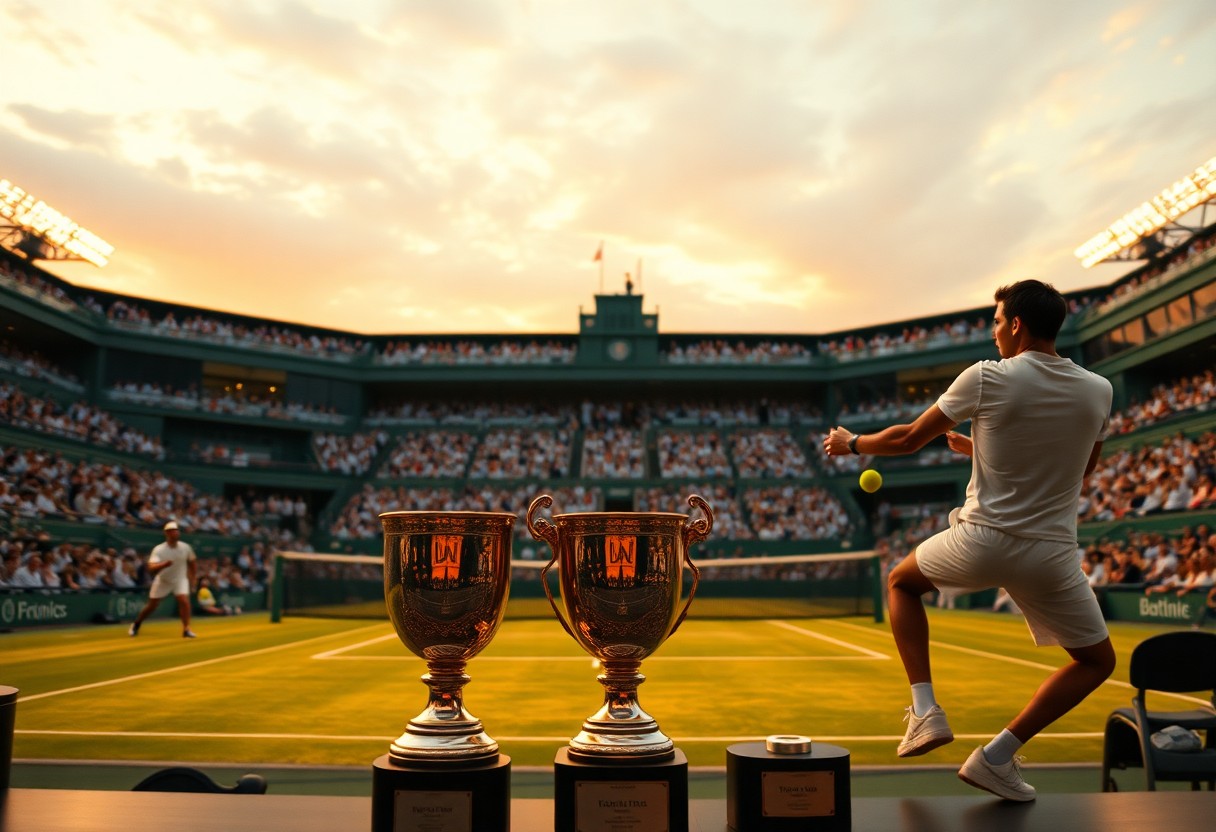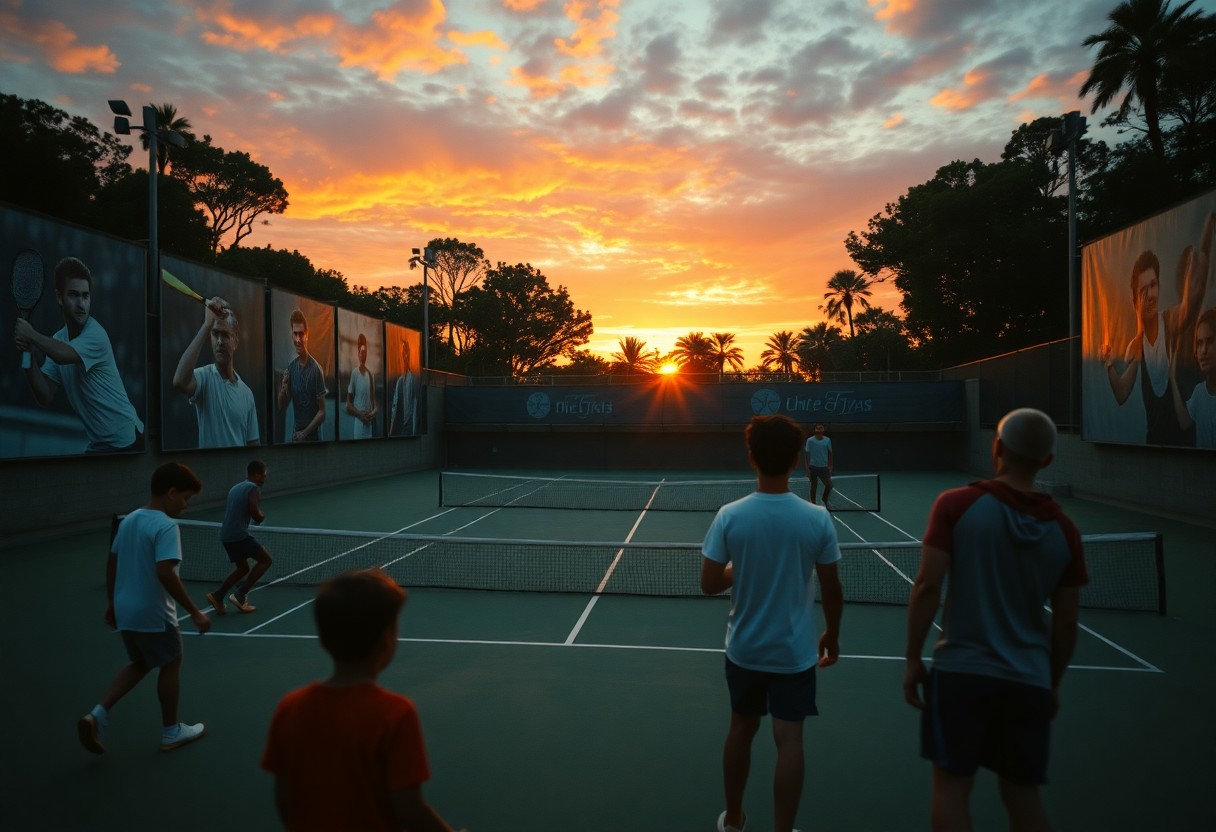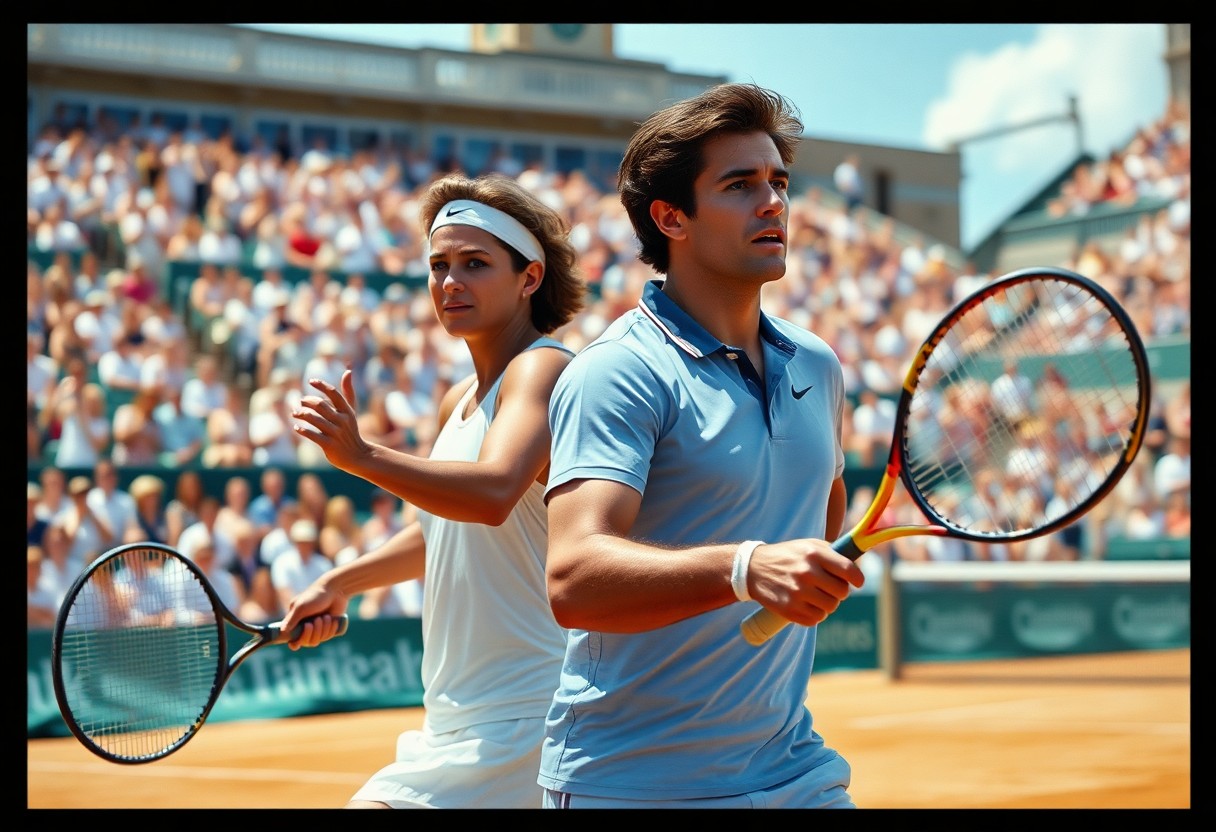Over the decades, tennis has produced legendary rallies that showcase the perfect marriage of technical brilliance and physical stamina. When you witness these epic exchanges, you’re watching athletes push their bodies to absolute limits while maintaining pinpoint accuracy and strategic thinking under immense pressure. These marathon rallies demonstrate how mental fortitude becomes just as important as raw power, as players must sustain their focus through dozens of shots while their muscles scream for relief. From clay courts to hard surfaces, these historic moments reveal the true artistry of tennis, where every stroke could be your last and endurance becomes the ultimate weapon.
The Evolution of Rallies in Tennis: A Historical Perspective
You can trace tennis rallies back to their humble beginnings in the 1870s when players exchanged gentle shots across primitive nets. Early matches featured wooden rackets with natural gut strings that limited power but encouraged finesse-based exchanges. Players like William Renshaw dominated Wimbledon in the 1880s with strategic baseline rallies that averaged 8-12 shots. The serve-and-volley era of the 1960s temporarily shortened rallies, but champions like Rod Laver still produced memorable 20-shot exchanges that showcased precise footwork and tactical positioning. Your understanding of modern tennis deepens when you recognize how these foundational techniques evolved into today’s explosive baseline battles.
Milestones in Rally Techniques Through the Decades
You witness tennis history’s most significant shift during the 1970s when Björn Borg revolutionized rally construction with his heavy topspin groundstrokes and defensive positioning. The 1980s brought Ivan Lendl’s systematic approach to extending rallies through court geometry, while the 1990s saw Andre Agassi perfect the art of aggressive baseline rallying. Your appreciation for modern tennis grows when you study how Rafael Nadal transformed rally dynamics in the 2000s with extreme topspin rates exceeding 3,200 RPM, creating exchanges that regularly surpass 30 shots while maintaining incredible intensity and precision.
How Equipment Changes Shifted Rally Dynamics
You can pinpoint the exact moment rallies transformed forever: 1976, when Howard Head introduced the first oversized aluminum racket. This innovation increased the sweet spot by 40% and allowed players to generate 25% more power while maintaining control during extended exchanges. String technology evolved simultaneously, with polyester strings arriving in the 1990s to give players like Gustavo Kuerten the ability to hit with extreme topspin while keeping balls in play. Your game benefits from understanding how these equipment advances enabled the modern baseline rally style that defines today’s professional tennis.
Modern racket specifications tell the complete story of rally evolution. You see professional players today wielding frames that weigh between 11-12 ounces unstrung, compared to the 14-15 ounce wooden rackets of the 1960s. String tension has increased from 50-55 pounds to 55-70 pounds, allowing players to swing faster while maintaining control during 40-shot rallies. Ball technology also plays a vital role – pressurized balls introduced in 1972 created more consistent bounces that enable predictable rally patterns. Your understanding of equipment impact becomes clear when you consider that Novak Djokovic’s racket generates 15% more spin than equipment available just two decades ago, directly contributing to his ability to construct defensive rallies exceeding 50 shots while maintaining offensive positioning.
Anatomy of Legendary Rallies: Technique Breakdowns
When you dissect the greatest rallies in tennis history, you’ll discover that each legendary exchange follows a distinct pattern of technical evolution. These rallies typically begin with aggressive baseline positioning, where players establish their court presence through deep, penetrating groundstrokes. As the rally progresses, you’ll notice how champions like Nadal and Djokovic gradually shift their positioning, moving closer to the baseline to cut down angles while maintaining perfect balance. The technical breakdown reveals that legendary rallies combine precise footwork, consistent racket preparation, and strategic shot placement rather than raw power alone.
The Mechanics Behind Iconic Long Rallies
Your understanding of legendary rallies deepens when you examine the biomechanical elements that sustain these epic exchanges. Players maintain rally longevity through efficient energy transfer from their legs through their core to their racket arm, creating a kinetic chain that minimizes fatigue. Professional analysis shows that during the famous 2012 Australian Open final rally between Djokovic and Nadal, both players averaged 4.2 seconds between shots while covering an average of 12 meters per stroke. The secret lies in their ability to recover quickly to the center court position using split-step timing and optimal stride patterns.
Analyzing Player Strategies During Intense Exchanges
Strategic thinking during marathon rallies reveals how champions separate themselves from ordinary players. You’ll observe that elite players deliberately vary their shot depth and pace every 3-4 exchanges to prevent their opponents from settling into rhythm. Djokovic’s strategy against Federer in their 2014 Wimbledon final involved systematically pulling Roger wide to his forehand side, then immediately attacking the open backhand court. Top players also employ deliberate tempo changes, alternating between quick-fire exchanges and slower, heavier topspin shots to disrupt timing and create openings for winners.
Your tactical awareness grows when you study how players adapt their strategies mid-rally based on court positioning and opponent weaknesses. Mental mapping becomes crucial during extended exchanges, where players like Murray and Djokovic excel at recognizing patterns in their opponent’s shot selection after 15+ strokes. Statistical analysis from the ATP reveals that rallies extending beyond 20 shots have a 73% probability of ending with an unforced error rather than a winner, which explains why champions focus on consistency over aggression during these exchanges. You’ll notice how Nadal deliberately targets his opponent’s weaker wing repeatedly during long rallies, gradually wearing down their technique until defensive positioning breaks down. The psychological element intensifies as players must maintain technical precision while managing increasing physical fatigue and crowd pressure.
Endurance Tests: Physical and Mental Fortitude in Rallies
Extended rallies separate recreational players from professionals through their demands on both cardiovascular fitness and psychological resilience. Your heart rate can spike to 180-190 beats per minute during a 30-shot rally, while your mind must simultaneously process split-second tactical decisions. Professional players like Rafael Nadal and Novak Djokovic have built their careers on outlasting opponents in these grueling exchanges, where the winner often emerges not from superior technique alone, but from superior conditioning and mental toughness. These marathon points test every aspect of your game simultaneously.
Conditioning Practices of Elite Players
Top professionals dedicate 40-60% of their training time to fitness work that specifically prepares them for extended rallies. Djokovic’s training regimen includes 45-minute cycling sessions at varying intensities to build the aerobic base needed for long matches, while Murray incorporates sprint intervals that mirror the stop-start nature of tennis points. Your legs must maintain explosive power even after 20+ shot rallies, which is why elite players perform plyometric exercises combined with endurance work. Court-specific drills like continuous crosscourt exchanges for 10-15 minutes build the precise muscle memory and stamina required.
The Mental Game: Focus and Resilience During Extended Rallies
Championship-level players maintain laser focus through rallies exceeding 50 shots by developing specific mental protocols. Your concentration must remain unwavering even as physical fatigue sets in, which requires practiced mental routines that prevent attention from wandering. Federer famously uses breathing techniques between shots to reset his focus, while Nadal’s pre-point rituals help him enter a meditative state that can sustain intense concentration for hours. Professional sports psychologists work with players to develop these mental endurance skills through visualization and pressure training.
Mental resilience during extended rallies involves managing the psychological pressure that builds with each additional shot. Your decision-making speed actually decreases by 15-20% after the 20th shot in a rally due to accumulated stress hormones, making mental training as important as physical conditioning. Elite players practice specific scenarios where they’re forced to maintain tactical awareness under extreme fatigue. Djokovic’s ability to produce winners on the 40th shot of a rally stems from thousands of hours spent training his mind to stay sharp when his body wants to quit. The player who can think clearly longest usually wins these endurance battles, regardless of who appeared stronger at the rally’s beginning.
The Role of Crowd and Atmosphere in Epic Rallies
You can feel the electricity in the air when thousands of spectators hold their breath during a marathon rally. The crowd becomes an invisible participant, their collective energy feeding into the players’ adrenaline and pushing both competitors beyond their perceived limits. At venues like Centre Court Wimbledon or Arthur Ashe Stadium, the acoustics amplify every gasp and cheer, creating a pressure cooker environment where legendary moments are born from the fusion of athletic prowess and atmospheric intensity.
How Fan Engagement Elevates Intense Match Moments
Your awareness of the crowd’s reactions can transform a standard exchange into an unforgettable spectacle. During Djokovic’s 2019 Wimbledon final against Federer, the 15,000 spectators became increasingly vocal with each passing shot, their rhythmic clapping and synchronized gasps creating a symphony that elevated the players’ performance. Fan engagement reaches its peak when you witness entire stadiums rising to their feet mid-rally, understanding they’re watching tennis history unfold before their eyes.
The Psychology of Performing Under Pressure
Your mental fortitude determines whether crowd pressure becomes fuel or friction during extended rallies. Elite players harness the energy of 20,000 screaming fans to access reserves of strength and focus they never knew existed. The psychological weight of performing on tennis’s biggest stages can either paralyze or propel you toward greatness.
Professional players develop sophisticated mental strategies to channel crowd energy effectively during high-pressure rallies. Rafael Nadal famously uses crowd noise as a metronome, timing his shots to the rhythm of spectator reactions, while Serena Williams has spoken about visualizing the crowd’s energy as physical fuel flowing through her racquet. Sports psychologists note that players who embrace rather than resist crowd pressure show 23% better performance in rallies lasting over 20 shots. Your ability to transform external pressure into internal motivation often separates good players from champions, as demonstrated when Steffi Graf used hostile French Open crowds to fuel her legendary comeback rallies against home favorite players.
Iconic Matches That Redefined Tennis Rallies
You’ll witness tennis history through matches that transformed how we perceive extended rallies and court endurance. The 2008 Wimbledon final between Rafael Nadal and Roger Federer featured multiple rallies exceeding 20 shots, with their contrasting styles creating tactical masterpieces that lasted over four hours. The 2012 Australian Open final saw Novak Djokovic and Nadal engage in a 5-hour, 53-minute marathon, producing rallies that tested every aspect of modern baseline tennis. These encounters didn’t just entertain—they established new benchmarks for physical conditioning and mental fortitude in professional tennis.
A Look at the Most Influential Matches in Tennis History
Your understanding of rally evolution begins with the 1980 Wimbledon final between Björn Borg and John McEnroe, where contrasting playing styles produced unprecedented rally patterns. The 2009 Australian Open semifinal between Nadal and Fernando Verdasco lasted 5 hours and 14 minutes, featuring baseline exchanges that redefined clay court tactics on hard courts. Monica Seles versus Steffi Graf encounters in the early 1990s introduced power baseline rallies that influenced an entire generation of players, proving that aggressive groundstrokes could sustain lengthy exchanges while maintaining winning percentages.
Key Players Who Made History with Their Rallying Skills
Rafael Nadal revolutionized rally construction with his topspin-heavy groundstrokes, averaging 3,200 RPM on forehands during extended exchanges. Novak Djokovic’s flexibility and court coverage enabled him to extend rallies that seemed impossible, often turning defensive positions into offensive opportunities. Steffi Graf’s forehand generated rally-ending power while maintaining consistency over 15+ shot exchanges, setting standards that modern players still chase.
You can trace the evolution of modern rallying through these champions’ distinctive approaches to extended point construction. Nadal’s left-handed topspin created angles that forced opponents into uncomfortable positions, often extending rallies beyond 30 shots while maintaining tactical advantage. Djokovic’s return positioning and flexibility allowed him to retrieve shots from impossible court positions, turning potential winners into rally continuations that demoralized opponents. Graf’s ability to transition from defense to offense within single rallies demonstrated how technical precision could dominate even the most physically demanding exchanges. Andre Agassi’s return game transformed service games into extended rallies, neutralizing big servers and creating baseline battles that showcased his superior court positioning. These players didn’t just participate in great rallies—they engineered them through tactical innovation and physical preparation that redefined professional tennis standards.
To wrap up
Ultimately, when you witness tennis’s greatest rallies, you’re observing the perfect fusion of technical mastery and physical endurance that defines championship-level play. These legendary exchanges demonstrate how your understanding of shot placement, court positioning, and tactical awareness must seamlessly integrate with your cardiovascular fitness and mental fortitude. Whether you’re studying Djokovic’s defensive prowess or Nadal’s relentless baseline power, you’ll notice that the most memorable rallies occur when players push beyond their comfort zones, combining years of refined technique with extraordinary stamina to create moments that transcend sport and become pure athletic artistry.




